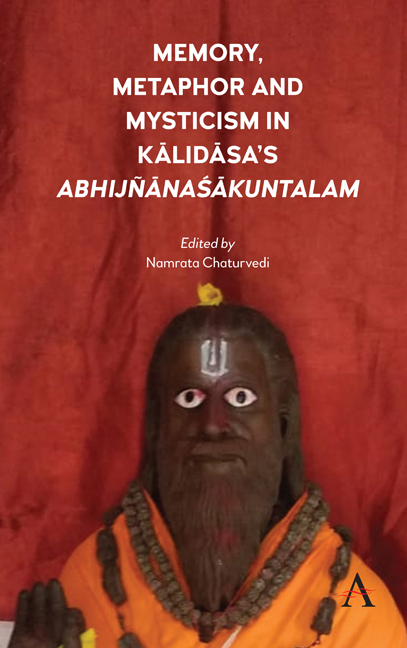Chapter 1 - ‘Upamā Kālidāsasya’: What Makes Kālidāsa the Kingof Metaphor
Published online by Cambridge University Press: 23 February 2022
Summary
Vāgarthaviva sampriktau vāgarthapratipattaye
Jagatah pitrau vande pārvatiparmeshvarau (Raghuvansham, I.1)
The opening verse of Kālidāsa's Raghuvansham describes the yoga (union) of vāka (word) and artha (meaning) as theyoga of Śiva andPārvatī. Every utterance in kāvya is therefore an act of carefularrangement (prabandha) in a manner that the completemeaning of the arrangement is revealed.
Ācārya Hazāriprasād Dwivedi understands the icchā-śakti (will) ofBrahma as universal chhand. This śakti of Brahma gives rise to variousforms of manifestations in arrangements, unique andparticular. He says,
Aisā jāan padta hai ki Kālidāsa isvishwavyavasthā ke mool mein ek vyāpak chhand kibaat sweekar karte hain. Yeh vishwavyāpak chhandsamashtigat cittaśakti ki sarjaneccha ya sishrashāke atirikta aur kuch nahīn hai […] Brahm kiicchā-śakti hi samashtigat chhand hai jisnesamasta bhedoabheda ka chhādan kar rakha hai.Chhādan karta hai isliye yeh chhand hai. Chhandarthāta icchā.
[It seems that Kālidāsa accepts the existence ofa visible chhand atthe root of this universe. This chhand is nothing but thewill (icchā) of thecosmic consciousness (citta-śakti). It is this will of Brahmathat has created and holds together the variousmanifestations of the phenomenal world. Therefore,chhand means will(icchā).]
Chhand is therefore thepower behind every arrangement, the power thatcovers (chhādan) themeaning. When Kālidāsa is declared the king ofpoetic utterance, it points towards the pratibhā(inspiration) in his work that sustains the play ofthe iccha-śakti ofBrahman.
The origin of Sanskrit chhand can be seen in the Vedas.Generally, chhandconsists of four charan (feet), but in Vedas, three orfive can also be found along with four. Sanskritkāvya chhand aredifferent from Vedic chhand as these are varnic (pertaining to syllable) andmātric (pertainingto mātra), whereas Vedic chhand is primarily varnic.
Varnic chhand is based onthe recognition of varṇa (syllable) and is of three types:samvritta, ardhasamvritta and vishamvritta. The mostpopular kind is samvritta, where each charan consists of the samenumber of varṇa. Theardhasamvritta is achhand where thenumber of varnas isthe same for even charans and the same for odd charans.
- Type
- Chapter
- Information
- Publisher: Anthem PressPrint publication year: 2020



